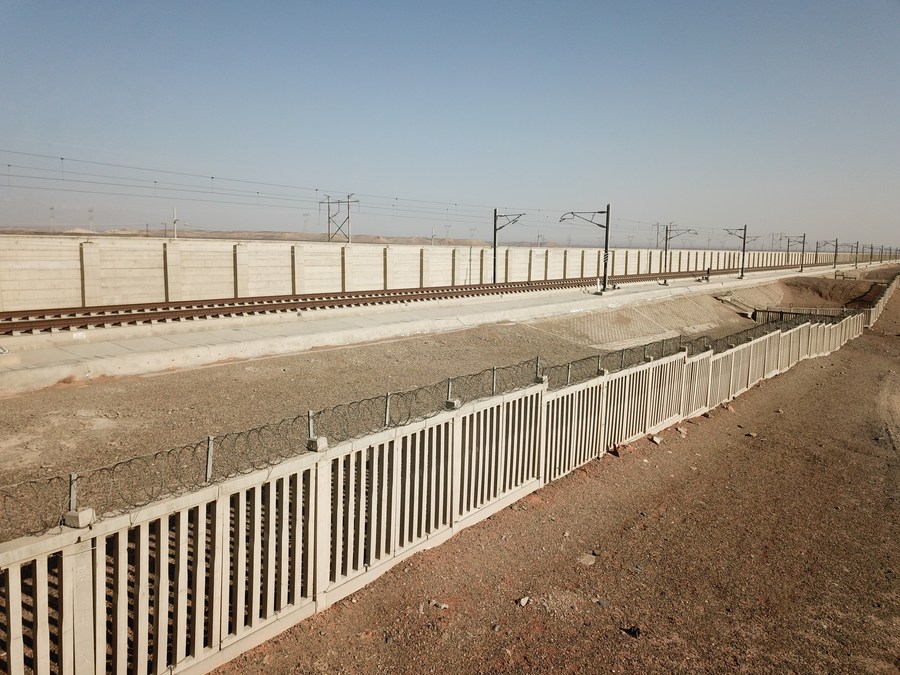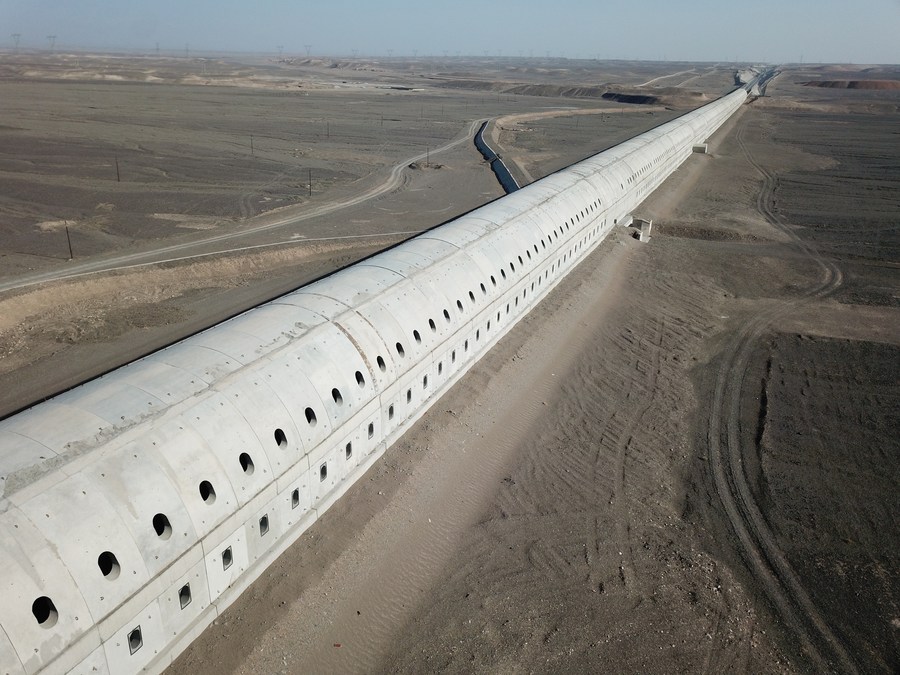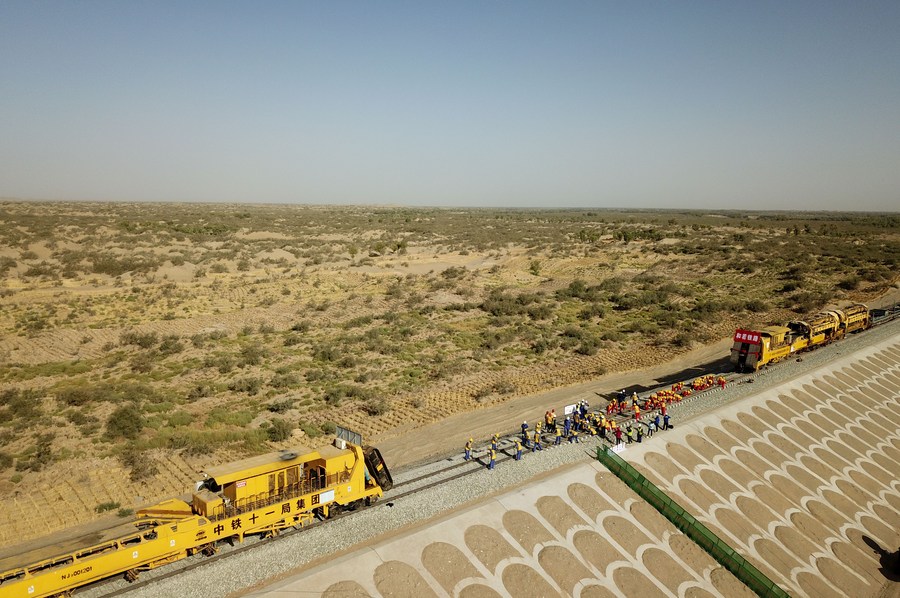-- The 1,776-km high-speed railway links Urumqi, capital of northwest China's Xinjiang Uygur Autonomous Region, with Lanzhou, capital of Gansu Province. Up to 462 km of the line in Xinjiang is located in windy areas.
-- When the Lanzhou-Urumqi high-speed railway became operational in 2014, a series of windbreak facilities were put into use, which greatly improved the safety and smoothness of train operations.
-- While railway operators have adopted windbreak facilities to battle wind and sand, railway construction workers near the Taklimakan Desert in Xinjiang have opted to plant trees.
by Xinhua writers Lyu Qiuping, Hao Yu and Aman
URUMQI, Nov. 26 (Xinhua) -- Yu Guorong was once afraid of the wind. For more than 30 years, the railway maintenance worker from northwest China's Xinjiang Uygur Autonomous Region has battled winds in the Gobi Desert to ensure safe rail operations.
Now, with the technology and windbreak facilities that have been adopted for a high-speed rail, he has found himself getting along with his invisible enemy.
The 1,776-km high-speed railway links the regional capital Urumqi with Lanzhou, capital of Gansu Province. Up to 462 km of the line in Xinjiang is located in windy areas. Some sections see winds at speeds of more than 20 meters per second for an average of 200 days a year, with the maximum wind speed exceeding 32 meters per second.

A bullet train runs on the Lanzhou-Urumqi high-speed railway in windy areas of Hami, northwest China's Xinjiang Uygur Autonomous Region, Nov. 12, 2014. (Photo by Hu Zhigang/Xinhua)
In the 1990s, when there were no high-speed railways, moving sand often buried the rail subgrade and rails, forcing train operations to be suspended.
Yu and his co-workers often had to remove sand from the rails using shovels in strong winds.
"To avoid being blown away, we had to tie ourselves with rope while working, with one end of the rope fastened to a concrete pole," Yu recalled.
When the Lanzhou-Urumqi high-speed railway became operational in 2014, a series of windbreak facilities were put into use, which greatly improved the safety and smoothness of train operations.

Photo taken on Nov. 24, 2021 shows the windbreak facilities constructed in windy areas of Hami, northwest China's Xinjiang Uygur Autonomous Region. (Xinhua/Aman)
At Liaodun north station in the city of Hami, dispatcher Wang Renjie monitors the wind speeds of different stations on a computer.
"The monitoring system automatically sounds an alarm if the wind speed exceeds 20 meters per second, and the dispatcher will warn related departments to activate an emergency plan," Wang said.
Rainfall, earthquake and snowfall can also be monitored by the natural disaster monitoring system.
WIND BARRIERS
Near the rails, there are concrete walls designed to be wind barriers. The walls span more than 340 km in Xinjiang, and have guaranteed train operations to a significant extent.
To prevent trains from being overturned by crosswinds, overground tunnels have also been built.
"Like armor, the tunnels shield the rails and the trains from crosswinds so that trains running at speeds of up to 250 km per hour can operate smoothly," Yu said.

Photo taken on Nov. 24, 2021 shows windproof overground tunnels constructed for high-speed railway in windy areas of Hami, northwest China's Xinjiang Uygur Autonomous Region. (Xinhua/Aman)
In a windy area, 120-plus railway bridges are equipped with steel board barriers. The boards have small holes and are fixed to the bridges with H-shaped steel pillars.
"The pillars and small holes are designed to prevent the steel boards from being blown away," he said.
GREEN SOLUTION
While railway operators have adopted windbreak facilities to battle wind and sand, railway construction workers near the Taklimakan Desert in Xinjiang have opted to plant trees.
"Sand control comes before railway construction," said Wang Jinzhong, who manages the company in charge of the construction of the Hotan-Ruoqiang Railway.

Aerial photo taken on Sept. 27, 2021 shows a section of the Hotan-Ruoqiang Railway undergoing track-laying work in northwest China's Xinjiang Uygur Autonomous Region. (Xinhua/Gu Yu)
As a key national railway project extending 825 km, the railway will link Hotan City with Ruoqiang County in the Bayingolin Mongolian Autonomous Prefecture, running through the southern edge of the Taklimakan Desert.
Workers have created straw grids covering an area of nearly 50 million square meters near the railway line, and they have planted nearly 13 million shrubs and trees, according to Wang.
"Tall trees have been planted along the outer areas to reduce wind speeds, while shrubs have been planted along the inner areas of the railway to fix the sand," said Wang, noting that automatic irrigation control has been realized using smartphones.
The railway line is expected to open in June 2022.
(Video Reporters: Aman and Hao Yu; Video Editors: Zhao Yuchao, Mu Xuyao and Zhu Jianhui) ■




